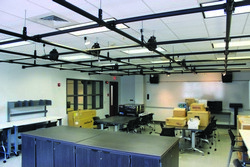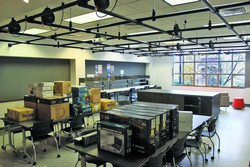Renovations for the Interactive Digital Media (IDM) Lab in room 135 of the Jules L. Plangere Jr. Center for Communication and Instructional Technology began this semester. The idea was proposed to the University by assistant professor Dickie Cox and is expected to welcome its first class, CO-404 Responsive Media, in spring 2019.
Cox said, “The [IDM] Lab will give students the opportunity to explore storytelling and content production for emerging and soon-to-be technological media platforms in socially responsible ways.”
Cox explained that the technologies in the research lab would morph with new discoveries and research over time. He said, “At the initial launch of the lab, the lab will have high-end virtual reality headsets, augmented reality headsets, game design software, interactive media programming software, computer vision hardware, digital fabrication tools, interactive exhibition tools, video projection re-mapping tools, creative coding tools, and an area for gaming research.”
One of the supporting faculty members for this project is Aaron Furgason, Ph.D., Chair of the Communication Department. Furgason said, “The new Interactive Digital Media program offers students across the University and the communication program, tools that will allow them to compete for employment in the tech-driven marketplace.”
Furgason explained, “The requirements for the program include classes in business, art, and computer science, which give all students tangible skills to meet marketplace demands within the communication field.”
Vice Provost for Graduate Studies, Mike Pallidino, is one of the administrators who sketched the proposal for the IDM. He said, “One priority of the Monmouth Strategic Plan is to focus on growing graduate programs which, in part, will help us create new opportunities for students and enhance our reputation as a university.”
Pallidino said that he was inspired to begin this project, which will be a new component of the IDM concentration in the Masters of Arts in the Communication degree, because he prioritizes new programs based on student interest, job opportunities and faculty expertise. He continued, “Through discussions with the School of Humanities and Social Sciences and the Department of Communication, we analyzed competing programs in the area. Key to the success of this program, we are fortunate to have an experienced faculty expert, Professor Dickie Cox, who could lead our curriculum development efforts by working with other faculty in communication who bring their expertise to the program.”
Furgason said, “The budget for this project is coming from a combination of the Provost’s office and the Department of Communication.” Furgason said that all numbers were estimated but the request for the equipment was about $100,000 renovation costs for additional power and new furniture as well, which came to about $25,000.
According to Cox, “The IDM curriculum is designed to prepare media producers and developers to be agile respondents to the perpetual shift, convergence, and remediation of emergent media platforms. IDM is a program that will always investigate early adoption of technologies and imagine how such technologies will be used to explore the social, cultural, and logistical impacts on our work values, communication, communities, and entertainment activities.”
 Cox said that there will be a handful of computer workstations in the lab, but they are high-end and will give students a huge range of engagement with lots of new technology and media. Cox added, “The space could be set up for a room-scale multiplayer VR experiment, for a group design-thinking exercise in the afternoon, a hackathon in the evening, and end the day with game night.”
Cox said that there will be a handful of computer workstations in the lab, but they are high-end and will give students a huge range of engagement with lots of new technology and media. Cox added, “The space could be set up for a room-scale multiplayer VR experiment, for a group design-thinking exercise in the afternoon, a hackathon in the evening, and end the day with game night.”
The project received support from university administration. Kenneth Womack, Dean of the School of Humanities and Social Sciences, said, “The renovation will be a great boon for our students as we contemplate new programs in the digital arts and communications. I am excited to be a part of the new endeavor as we plot Monmouth’s future.”
John Morano, Professor of Journalism, said that he is excited to see what this renovation does for Monmouth University, especially from a journalistic standpoint. He said, “What we’ll be able to do is take readers to the location of the story and rather than describe the location we can walk them through it and they can actually see it in a virtual reality format. This is cutting-edge technology that journalism students will be exposed to in our program.”
Anne Skimmons, a senior art design student, said that if she moves forward with applying to the graduate program, she would use this room. If she does not find a use for it, she plans to encourage her younger peers that attend Monmouth University to explore it. Skimmons said, “The new IDM Center would absolutely help me obtain my academic and professional goals. I wish it had been built before I completed my undergrad, but in case I decide to return to school, it would certainly take my skills to the next level and encourage me to be better; not only in my classroom education but in my confidence to produce media in the real world professionally.”
Cox said that he is hoping to have the first class, CO-404 Responsive Media, in the IDM Research Lab in spring of 2019. He said, “IDM is a new concentration in our Master of Arts in Communication in the Department of Communication. That concentration is on the books as of this academic year, but we are expecting our inaugural cohort of graduate students in the fall of 2019. We believe that having graduates working with these new tools on campus will likely raise the profile and interest among the undergraduate population too.” He explained that this would be another student laboratory in the Communication Department just like WMCX, The Outlook, PRSSA, The Verge, Hawk TV, CommWorks, and MOCC. There will be classes that use the lab for their coursework. During non-class times in the lab, he encourages faculty and student research teams to use the space to develop their creative ideas, research, and scholarship.
Cox said that the Interactive Digital Media technology has been around in big research schools such as NYU for over 20 years, and in the last 3-5 years, comprehensive schools such as Monmouth University are gradually picking it up. Cox was inspired by a quote from Red Burns, Founder of the Interactive Telecommunications Program at NYU, who said, “At moments of change in technology, you need to experiment. Most importantly you need to play. You need to have an environment that encourages people to try new things and to begin to look and see what you could do.”
Cox explained, “I want to humanize technology and hopefully the renovations of this room is the first step.”
PHOTOS TAKEN by Nicole Riddle


